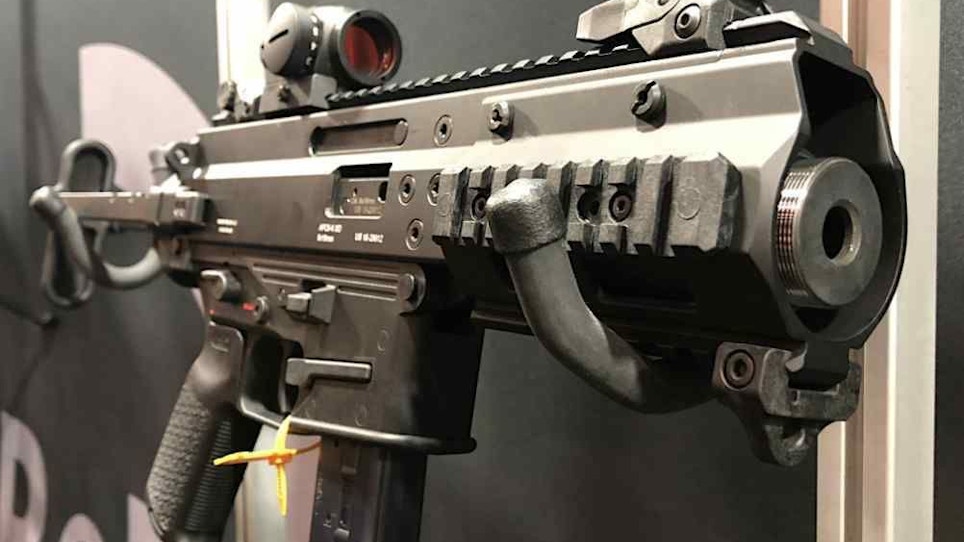Ever since firearms were created, there’s been a desire to pack as much lethality as possible into as small a package as possible. For example, the pistol caliber submachine gun (SMG) has been around longer than the modern assault rifle with its intermediate cartridge. Today we are seeing a resurgence of the more compact design of the SMG.
Even before World War I, various manufacturers offered fully automatic versions of their pistols fitted with drum magazines and shoulder stocks to enhance stability. As they were pistol calibers, they were great for close work such as trench sweeping, but lacked the stability or range to effectively engage far targets.
Because of that, others created cut-down versions of rifles. These carbine and smaller length weapons offered an advantage over SMGs with increased caliber in a package more manageable than rifles in confined spaces.
With that increased caliber in a compact form, came a perceived threat. Readily available, these “short barreled rifles” along with full automatic weapons and silencers were vilified in popular culture and unfortunately came under strict control of the National Firearms Act Of 1934.
A third category of compact weapons arose. The submachine gun was a bit of a hybrid, combining pistol calibers for controllability and weight with a larger package that increased stability while firing.
World War II saw the use of the Thompson SMG as well as the M-3 Grease Gun with its stamped steel construction for ease of manufacture and to control costs. The Grease Gun soldiered on for half a century while the Thompson fell out of favor due to its weight.
Despite most soldiers carrying a full-sized battle rifle in the .30-06 M1 Garand, the Army introduced the M1 Carbine, with its .30 Carbine ammunition and smaller dimensions. This was followed by the select-fire M2 Carbine. Both of those more compact weapons were used well into the Vietnam War.
The adoption of the M-16A1 was the first U.S. foray into a general issue assault rifle. It combined a detachable magazine, an intermediate cartridge and associated weapon size as well as full automatic fire. Even then, there was a need for a carbine version. The CAR-15 transitioned into the M-4 carbine, which is now standard issue to Army and Marine Infantry, as well as Special Forces.
In addition to the M-16 family, the U.S. Army has adopted a variety of submachine guns throughout the years. Although the H&K MP-5 was used for decades by Special Operations Forces as well as select Marine Corps units, the U.S. Army hasn’t had a dedicated SMG since the M-3 Grease Gun was removed from service after the first Gulf War. Even then, its use had been relegated to just armor troops.
But the requirement for an SMG hasn’t gone away. It’s just a question of who will use it and what it’s called. Last year, the U.S. Army released a requirement for a Sub Compact Weapon (SCW). Taking a note from the original 9mm Colt SMG, the Army asked industry to provide a highly concealable SCW system capable of engaging threat personnel with a high volume of lethal force while accurately firing at close range with minimal collateral damage. Consequently, the weapon has to be optimized for shooting the 147-grain 9mm cartridge.
Reawakening the concept was the requirement to outfit Personal Security Details (PSD) for High Risk Personnel (HRP) such as senior commanders and key personnel. To address that operational need, PSD military personnel, which are generally Military Policemen by trade, require weapons with greater lethality than pistols, but that are also more concealable than rifles.
Five companies were selected to provide prototypes for this fast track acquisition. They include: Angstadt Arms with the SCW-9; Brugger & Thomet with their APC9 and APC9-K SD; Global Ordnance with the Slovakian STRIBOG; Shield Arms with their SA9K; and SIG SAUER with a version of their MPX
Due to the small overall footprint of the SCW requirement, only one of the candidates mimics an AR pattern weapon and it began development as a commercial pistol caliber carbine. The others all rely upon proprietary designs originating in Europe, where SMG use has been continuous with both military and police. Interestingly, although the goal of the program is to purchase a weapon that can be operated while suppressed, only one (B&T) included an integral suppressor.
Ultimately, the Army only plans to purchase up to 1,000 SCWs, but having a solution in the system will make it available to other Department of Defense organizations. Compact weapons with high rates of fire remain an important tool in the arsenal of democracy.
What’s more, development of this class of weapons continues to be commercially viable thanks to a resurgence of interest in pistol caliber carbines, as well as their short barrel rifle variants here in the United States.






